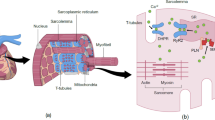Background:
Diastolic dysfunction is increasingly recognized as a cause of symptomatic heart failure, including the clinical syndrome congestive heart failure (CHF). Metaanalyses of earlier studies of this disorder suggest 40–50% of patients with congestive heart failure have preserved left ventricular systolic function. Conditions associated with diastolic dysfunction are diverse and most commonly include ischemic cardiomyopathy with previous myocardial infarction(s) and hypertensive heart disease.
Pathophysiology: An underlying histopathologic finding in each of these entities is an adverse accumulation and structural remodeling of the heart's fibrillar collagen matrix expressed as cardiac fibrosis. In ventricular tissue fibrosis serves to impose a viscoelastic burden that compromises all of diastole, including the rate of relaxation, diastolic suction and passive stiffness. Various factors contribute to the abnormal accumulation of this fibrillar matrix. Of particular importance are effector hormones of the renin-angiotensin-aldosterone system.
Treatment: In experimental studies, pharmacologic interference with each of these circulating hormones, either through ACE inhibition or respective receptor antagonism, proves cardioprotective by preventing fibrosis while preserving diastolic function. Additionally, a regression of established cardiac fibrosis by its presumptive proteolytic digestion induced by ACE inhibition or AT1 receptor antagonism has been demonstrated. This cardioprotective strategy improves tissue stiffness and suggests diastolic dysfunction is reversible.
Hintergrund:
Die diastolische Dysfunktion wird zunehmend als Ursache einer symptomatischen Herzinsuffizienz akzeptiert. Metaanalysen lassen vermuten, daß 40–50% der Patienten mit kongestiver Herzinsuffizienz eine weitgehend intakte linksventrikuläre systolische Funktion aufweisen. Die pathogenetischen relevanten Faktoren für eine diastolische Dysfunktion sind recht unterschiedlich und umfassen am häufigsten die ischämische Kardiomyopathie nach Herzinfarkt und das Hypertonieherz.
Pathophysiologie: Histopathologisch findet man in der Regel eine kardiale Fibrose. Das fibrilläre Kollagen ist dysproportional vermehrt und im Sinne eines pathologischen Remodeling in der Matrix angereichtert. Muskelmechanisch gesehen ist die viskoelastische Belastung erhöht, damit ebenso die Erschlaffunggeschwindigkeit, der diastolische Sog und die passive Steifigkeit. Zur pathologischen Vermehrung der extrazellulären Matrix tragen viele Faktoren bei. Von Bedeutung sind die Effektorhormone des Renin-Angiotensin-Aldosteron-Systems.
Behandlung: In tierexperimentellen Untersuchungen ließ sich bei Blockade jedes dieser Effektorhormone ein kardioprotektiver Effekt mit Verhinderung der Fibrose und Erhaltung einer normalen diastolischen Funktion zeigen. Der kausale Mechanismus erfolgte entweder über eine Inhibition des ACE-Systems oder eine direkte Rezeptorblockade. Zusätzlich ist von einer Regression der vorbestehenden kardialen Fibrose durch einen vermehrten proteolytischen Abbau durch ACE-Inhibition oder AT1-Rezeptor Antagonismus auszugehen. Diese “Kardioreparation” vermindert die Steifigkeit und legt nahe, dass die diastolische Dysfunktion tatsächlich reversibel ist.
Similar content being viewed by others
Author information
Authors and Affiliations
Rights and permissions
About this article
Cite this article
Burlew, B., Weber, K. Cardiac Fibrosis as a Cause of Diastolic Dysfunction. Herz 27, 92–98 (2002). https://doi.org/10.1007/s00059-002-2354-y
Published:
Issue Date:
DOI: https://doi.org/10.1007/s00059-002-2354-y




